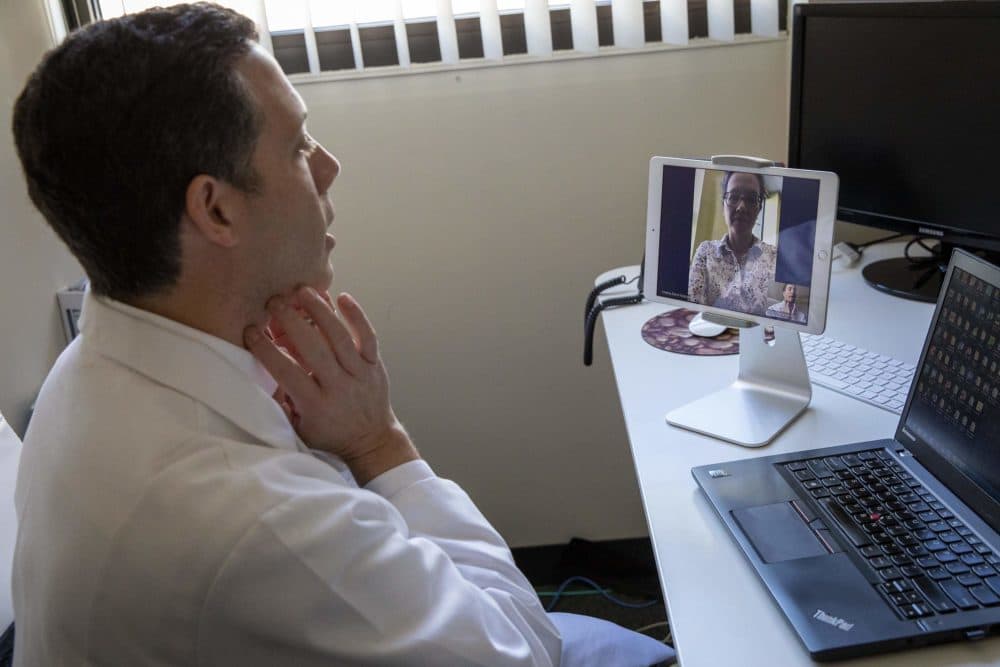Advertisement
Virtual Visits: Virus Spurs Explosive Growth Of Long-Lagging Telemedicine

If you have any upcoming medical appointments, perhaps you’ve gotten a recent voicemail like this:
"As a precautionary measure, we’re going to change your appointment from an in-person visit to a telephone visit," says a pleasant voice. "The reason that we're scheduling phone visits where possible is to keep you and other patients safe, by eliminating the need to come into the office at this time."
Whether by phone or video or online chat, telemedicine is exploding as a result of the coronavirus outbreak. This massive shift to “virtual visits” was slow in coming — until now.
Nearly 20 years ago, Dr. Lee Schwamm helped pioneer what was called “telestroke” treatment — connecting stroke specialists by video link with remote doctors who needed an urgent consultation. It showed telemedicine could be helpful and easy to use, even back then, before everyone was using FaceTime and Skype, but there was no instant tele-revolution, Schwamm says.
"There’ve been several really important barriers," he says. "The first one is that the laws that regulate the practice of medicine are quite arcane."
There were privacy concerns. Billing complexities. There was resistance from insurance companies who saw so-called “virtual visits” as similar to phone calls, which they do not reimburse for.
"All those concerns have now evaporated in the face of a crisis where everyone is now scrambling to try to keep doctors and patients separate, but still provide care and quell a large tide of rising anxiety among the public," Schwamm says.
Schwamm is a neurologist and the vice president in charge of virtual care for the state’s biggest hospital chain, Partners Health Care. That means he’s working 16-hour days right now to shift as many health care staffers as possible toward virtual care, including video visits and Web chats.
He says about 400 or so Partners staffers had already been actively using video visits.
Advertisement
"Our job now is to turn that virtual visit program on for 11,000 providers as fast as we can," he says.
It’s a shift happening across health care, as clinics and hospitals try to protect patients and keep staffers from becoming infected with the coronavirus.
And it’s getting a major boost from government action, including 500 million dollars for telehealth expansion in a new law President Trump signed, his administration's lifting of telehealth restrictions for seniors on Medicare.
Massachusetts Governor Charlie Baker issued an order on Monday requiring private insurers to cover virtual visits the same way they cover in-person visits.
Though Massachusetts is seen as a leader both in health care and in technology, its adoption of telemedicine has lagged.
"We’re 50th out of 50 states for adoption," says Dr. Joseph Kvedar, the president-elect of the American Telemedicine Association.
A state report out this month finds the rate of telehealth usage doubled in Massachusetts between 2015 and 2017 but still remained 39% lower than the national rate.
At the Kenmore Square operations center of the Atrius Health medical network on Wednesday, Dr. Philip Ciampa ran a staff training on how to do a virtual visit with a possible coronavirus patient. As he spoke to a mock patient who'd had fever and chills for a day or so, he could took a virtual look at her via video.
"I can tell that your respiratory rate is normal right now," he said, "and I can also tell that you’re not using any accessory muscles to breathe and that your breath is comfortable."
Patients can be asked to tap out their pulse rate, he explained, and to take their own blood pressure and temperature if they have the tools.
Ciampa is the chief innovation engineer for Atrius Health, and has been working to scale up virtual visits since 2016.
"In the last four weeks, we’ve accomplished more than in the last four years on this topic," he says.
At Atrius, virtual care is being used to triage patients concerned about possible coronavirus, and Ciampa says it’s also being ramped up for non-coronavirus concerns to let other patients avoid office visits as well.
At Partners, virtual care also includes Ipads mounted on IV poles near inpatients who may have the coronavirus, Lee Schwamm says. That lets nurses communicate with them without having to risk infection by going into the room. And work is under way on a chatbot to help patients figure out if they may have the virus and what to do next.
"We’re getting swamped by requests for advice and help, which is totally understandable," and which technology can help alleviate, he says.
So, when the coronavirus outbreak is over, how much of this “virtual care” will remain?
Dr. Kvedar of the president-elect of the American Telemedicine Association, says face-to-face visits won’t go away — they can be uniquely valuable — but virtual visits should be part of routine care.
"What I speculate on," he says, "is: after the dust settles, and we know it will, will patients want to go back? Will they sort of say, 'Hey, you know I had that, I don’t know why we can’t keep doing it that way?’"
This segment aired on March 19, 2020.
